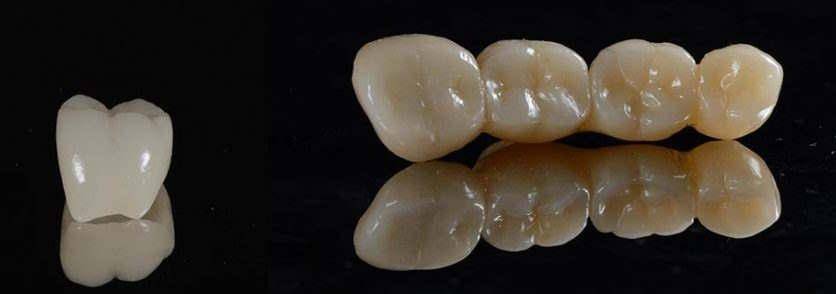Menu

Traditional methods to replace a missing tooth or teeth include the fabrication of a dental bridge. To replace a missing tooth with a dental bridge, at least one tooth on either side of the space created by the missing tooth must be prepared for a crown. Then a false tooth is joined to the crowns, and the entire structure is cemented to the prepared teeth. The patient cannot remove the dental bridge, and special aids are available to keep it clean.
Dental Crown is a tooth-like covering placed over a carefully prepared existing tooth. Used to strengthen, restore or improve the appearance of your natural tooth a dental crown is placed on an individual tooth much like a thimble over your finger. One of the most common is to support the tooth when there is no longer sufficient tooth structure left to place a filling. There are several ways of restoring teeth, the most common being a filling or bonding. Dental Crowns are used to strengthen a tooth and repair badly decayed, broken, severely discolored, misaligned teeth or capped the tooth after root canal treatment. Dental Crowns may also be used to protect the structure of a tooth that is fractured or broken. Dental Crowns completely cover teeth, restoring them to their natural color, size, shape, and function. The location of the dental crown in the mouth usually dictates the type of material used. The tooth under the dental crown is reduced in size. The dental crown will be permanently cemented over the reduced tooth. While you are waiting for the permanent dental crown to be fabricated, your dentist will provide you with a temporary one to wear. Dental Crowns have a much longer life span than bonding, resist stains better, hold their color and resist chipping and cracking. Dental Crowns, however, take longer to prepare than bonding and are not reversible. Your dentist can recommend which type of restoration is best for your particular situation. If the tooth is severely decayed, little tooth structure remains or after root canal treatment for the back tooth, it may be necessary to place a metal post into the tooth to support the dental crown. If this is the case, root canal therapy will be performed.
Porcelain fused to metal is mainly comprise of porcelain and metal alloy basis. The combination of porcelain bonded to a supporting structure of metal creates a stronger restoration than porcelain used alone. The metal provides strength to crown and bridge while porcelain replace natural teeth enamel appearance. Dental crown and dental bridge restorations are traditionally used for 40-50 years. It is successfully proved to be very strong and durable. Porcelain or ceramic is favored in dentistry for its aesthetic qualities and durability.
Because porcelain fused to Metal has disadvantages for biocompatible, some patients show allergic sensitivity after use dental crowns and dental bridges 1-2 years because of some particular alloys used in dental crown and dental bridge. So, full-porcelain (metal free) play key roles in this kinds of patients. Full porcelain restoration is made of dental materials include porcelain, ceramic or glasslike fillings and crowns. They are also used as inlay/onlay, dental crowns and dental veneers. Full-porcelain restorations are particularly desirable because their color and translucency similar to natural teeth. The disadvantage of full porcelain over porcelain fused to metal is resistant to fracture when placed under tension or on impact. The strength of this type of restoration depends on an adequate thickness of porcelain and the ability to be bonded to the underlying tooth. They are highly resistant to wear but the porcelain can quickly wear opposing teeth if the porcelain surface becomes rough.
Zirconia is widely used in space industry from space suit aircraft parts because of its durable and erosion resistant. Zirconia is the same component of jewelry sub-structure and more suitable for posterior teeth where require greater loading chewing forces. This is latest ceramic technology and the most strength materials in Dentistry market to make dental crown and dental bridge at the moment.
Here’s a detailed comparison between dental bridge and dental implants to help you decide which option is best for you:
| Feature | Dental Implants | Dental Bridges |
|---|---|---|
| Support | Standalone by jawbone | Anchored to neighboring teeth |
| Stability | Very stable and feels like natural teeth | Stable but depends on neighboring teeth |
| Bone Preservation | Prevents bone loss | Does not stimulate bone |
| Longevity | Over 20 years for implant, 10 years for crown over | 10 to 15 years |
| Tooth Impact | No damage to nearby teeth | Requires shaving healthy teeth |
| Appearance | Very natural and life-like | Natural, but less lifelike over time |
| Maintenance | Brush and floss like natural teeth | Special flossing tools needed |
| Procedure Time | Require healing period 3 months | 7-10 days |
| Cost | Higher upfront cost | Lower initial cost |
| Suitability | Ideal for single or multiple missing teeth | Better for a few teeth and no returning to Pattaya |
Dental Center by specialist. Dental cleaning, Teeth whitening, Implant, Cosmetic, full mouth restoration.
Smile Dental Center
111/76-77 South Pattaya road Nongprue, Banglamung Chonburi 20150 Tel: 083 066 9486
Everyday: 10:00 – 20:00